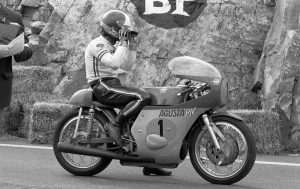Many MotoGP fans may think it a left-field decision to have Triumph providing the engines for Moto2 from next year, but it makes total sense for many of us former Seventies longhairs.
As well as Triumph’s deal with Dorna bringing a three-cylinder powerplant onto the grid that has totally different characteristics to Honda’s inline four, it also harks back to a period of racing heroics.
In the late 60s and early 70s, the world’s most winning grand prix racer was going about his business on a range of MV Agustas with varying engine configurations. Today, Giacomo Agostini nominates MV’s three-cylinder engine as his favourite.
At the same time Triumph-BSA’s production-based triple was a frontrunner in the fledgling Formula 750 class. Eventually Ago’s MV and Triumph’s Trident, rebadged as a BSA, would go head-to-head in a one-off race with an unexpected result.
The soundtrack to those golden days was played by Triumph through a three-into-one open-megaphone exhaust. In the case of the MV, the song was sung through three long trumpets that snaked back along the chassis, two on one side and a single pipe on the other. The result was a spine-chilling howl unique to that period of racing. That three-cylinder symphony will return as a key element of next season’s Moto2 marketing.
Triumph’s pushrod three-cylinder Trident won the Isle of Man Production TT five years in a row from 1971 to underline the British model’s durability against a growing onslaught of Japanese technical sophistication. But a year earlier Gene Romero gave the Trident real racing kudos when he set the fastest ever motorcycle lap on Daytona’s famous Speedbowl. His team took the advice of a US tyre expert and put a front tyre on the rear wheel to reduce rolling resistance. It lasted just three laps but Romero set the-then astounding time of 157.342mph with a top speed of 165mph.
Triumph’s yearly expedition to the Daytona 200 started back in the mid-1960s when engineer Doug Hele developed Triumph’s 500cc street twin into a racer capable of winning America’s richest race. The same effort was put into the Trident-based racers, built into special frames constructed by chassis legend Rob North.
Their sturdy cradle design was largely repeated in Suzuki’s GSX-R750, a bike that reinvented the sports motorcycle in the mid-1980s.
Paul Smart, a winner on both Triumphs and Ducatis in the early 1970s, told me a couple of years ago he considered Hele and Ducati’s Fabio Taglioni equals. Both were modest backroom boys quietly pushing the boundaries of technology with limited resources and small budgets.
Former Triumph Australia technical manager Gary McDonald has fond teenage memories of those days when as an apprentice mechanic he was sent to help out the team in the rush for Daytona.
“When we took the bikes to the MIRA testing grounds in the Midlands, a major car manufacturer was there with its Le Mans race team,” he told me. “All the mechanics dropped their tools and ran to the wall to watch and hear our Rob North triples at full revs.”
The 1971 year of international racing was the highpoint for Triumph-BSA triples with wins at Daytona, victories in all six races of the inaugural Anglo-American Match Races, followed by first and second places at the F750 Isle of Man TT, and first place at the Bol d’Or 24-hour endurance classic.
Meanwhile Ago sauntered to his 10th world Grand Prix title with eight wins out of 11 on the MV.
There was just one high-profile race left for 1971, the Race of the Year at Mallory Park in the UK. The virtually unbeatable Ago and his exotic three-cylinder MV were expected to romp home but the dashing international playboy was beaten by old-school Pommie tough nut John Cooper.
He survived a spectacular out-of-the-seat moment to take victory by half a second.
Sounds a bit like a typical Moto2 win, doesn’t it?
That is the spectacle MotoGP’s mover and shakers are hoping to recreate for next season.
By Hamish Cooper
